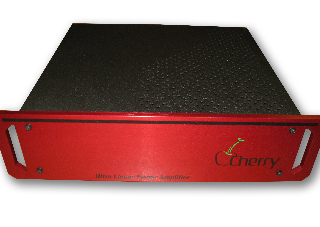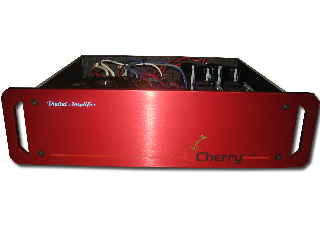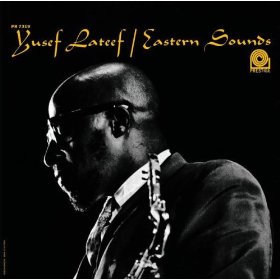The Digital Amplifier Company Cherry Plus Amplifier
| A Cherry Topping Indeed! |
|
|
|
September 2010 |

At the ’98 Consumer Electronics Show, on my first trip to Las Vegas (also known as Sin City) is where I heard the world’s first digital high-end amplifier in the Tact Audio Millennium (asking price in those far off days was $9,800). It was my first experience with a Class D (so-called “digital”) amplifier. Almost immediately, the audio press gushed all over this digital dynamo. The Millennium became an instant sensation and by the fall of 2001, it garnered nearly every prestigious award I can think of. Serendipitously, I discovered that the Tact facility was situated a mere 12 miles from my New Jersey home. That gave me opportunities to personally audition improvements to the amplifier as well as newer product lines. I took a leap of faith the very next year by adding their Tact 2.2XP Room Correction preamp to my system. And I never looked back.
Over the years, I’ve witnessed many breeds of new and fascinating Class D amplifiers that made their way onto the high-end audio scene. Despite all the claims and arguments as to why “Our amp is better than theirs,” not to mention the different names manufacturers chose to distinguish their particular implementation of the Class D modulation and output stages — Digital, Class T, I.C.E Power — all these amplifiers had one thing in common: over 90 percent efficiency. A Class D amplifier weighing sometimes far less than 20 pounds, running only slightly warm to the touch, with minimal or no heat sinks, while producing 300 – 1000 watts per channel, is rather common today.
More recently ingenious designs by Joey White (Haphaestus) and Tommy O’Brien (Digital Amplifier Company) have introduced new Class D-based amplifiers that do not outsource circuit boards, and employ superior components and shorter signal paths, and thus are less prone to inherent signal degradation and induced distortions. In short: they claim to sound better than their conventional counterparts.
In July 2010, I reviewed the 1000-watt mini-titans from Haphaestus and found them to be among the best sounding Class D amplifiers to have graced my listening space, a real winner at their $5,000 asking price. But not long thereafter, I received an email from Stereo Times editor Larry Borden concerning yet another Class D amplifier that Larry thought I might want to audition. To be honest, my curiosity was piqued by the name of the manufacturer: Digital Amplifier Company. I telephoned D.A.C. in Allentown, Pennsylvania and spoke with Tommy O’Brien whom I found to be quite personable. I later learned he’s a highly competent designer with an impressive curriculum vitae and three patents to his credit. Although his name may be new to the high-end audio scene, his Digital Amplifier Company has been around since 1996 — mainly manufacturing professional, home theater and car audio equipment. Because of O’Brien’s rather impressive background, I wanted to hear what he could do and asked about auditioning and possibly reviewing his top-of-the-line ($4,999) Cherry Plus amplifier. (O’Brien also manufactures three less-expensive models: the DAC4800, Cherry, and Cherry Jr., and there’s a mono-block design looming on the horizon).
The Cherry Plus is a departure from the diminutive designs I’ve come to associate with the newer Class D amplifiers. It’s bigger than the mono-block Haphaestus and Red Dragon (based on ICE Power) amps currently on my equipment rack. The Cherry Plus more closely resembles a conventional Class A/B stereo design in terms of heft, size and weight. It tips the scales at 40 pounds and atypically has a 1500 watt toroidal transformer in the power supply! However, given the absence of heat sinks and a hefty power rating of over 400 watts per channel into 8 ohms, this design suggests, “Yes, this is Class D, but far from average.”

In one of our many email correspondences, O’Brien wrote: “At Digital Amp Co., we understand the difference between bench measurements and sound quality. We started off with a design that was amazing on the bench (0.0005% THD, for example) and sounded “very good” — then we tweaked the design over years of listening. The result was “great” instead of just “very good.” Most amplifier manufacturers don’t have in-house technology development resources, so they rely on pre-fab subsystems from other companies that they don’t fully understand. They employ junior engineers that aren’t capable of complex mixed signal design. Some manufacturers have even hired switching power supply designers (who never designed an amp before) to design Class-D amplifiers with terrible sonic results! This initially gave Class-D a bad reputation. I knew Class-D could be so much better and watched in frustration as it entered the consumer market. Semiconductor companies added to the frustration by trying to “dumb down” Class-D design — producing crappy amplifiers with awful specs like 10% THD at rated power. I cringed as some of them even made up their own fake amplifier class designations (like “Class-T” — this is really Class-D, folks)! The shortcuts that the “other guys” take in order to produce an amplifier added to the gobs of cash that they spend on marketing versus development means that you can wind up getting very little for your money if you’re not careful. “
A glance at the rear of Cherry Plus impressed me by the fact O’Brien chose only balanced inputs for this design (but does supply adapters for those who use unbalanced cables). European 5-way speaker binding posts also come standard. Directly above the IEC connector is the power on/off rocker switch; a 15-amp breaker button and remote toggle are situated to the left. As for the Cherry Plus’s aesthetics and overall look, I do not like its cherry-colored faceplate. I think it draws unnecessary attention to itself (and it also reminds me of my days on the pro-circuit working with cheaply built, high-powered club amplifiers). The side hand-rails on the Cherry Plus’s faceplate help give it a rather pro-application look and a utilitarian feel which I also do not care for. Of course, visual aesthetic judgement has nothing to do with sonic capabilities or, in my case, a purchase decision. On the other hand, I am aware of many audiophiles for whom the visual aesthetic is very important, and who wouldn’t hesitate to look elsewhere solely because of it. Yes, I suspect the sad truth is that some audiophiles will not purchase this amplifier regardless of its sonic merits. Which are, indeed, wonderful.
I was immediately impressed by the Cherry Plus right out of the box. Connected to a pair of Revolver Music Series One mini-monitors via Purist Audio Proteus Provectus cabling (review forthcoming), using the Behold Gentle integrated as a preamp/DAC and PS Audio Perfect Wave transport, I could hear almost instantly how the Cherry Plus provided a superb disappearing act with these little Revolvers. Be it jazz or classical, voice or instrumental, there existed a rare sense of ‘quiet’ that started at the highest frequencies and continued right down through the midrange and bass (mid-bass in the case of these loudspeakers). This, aided by a welcome heftiness to the low-end, gave the Revolvers a bigger sound stage than I am used to. In addition, there was an added sense of focus, image stability and spaciousness. And the Cherry Plus’s sonic attributes continued to improve over time as I played a wide variety of music through it.
 Love Theme from Spartacus by saxophone great Yusef Lafeef, from his highly-regarded Eastern Sounds album, is among my favorite jazz CDs from the 1960s. Whenever I play this particular track I’m reminded of a time when great jazz music was at its most inventive and intense. Recorded in 1961 (here in New Jersey) on the Prestige label, this is — at best — only a decently engineered CD. However, what I have always enjoyed about it is the incredible musicianship and genius of Yusef on oboe that is captured. As usual for that period, the sound is heavily panned, with Barry Harris on piano coming stage right, and drummer Lex Humphries stage left. Bassist Ernie Farrow falls nicely between the two (closer to center however), with Yusef taking center spotlight on oboe. The original melody of Love Theme is absolutely beautiful but to hear this heavily influenced middle-eastern motif is just breath-taking.
Love Theme from Spartacus by saxophone great Yusef Lafeef, from his highly-regarded Eastern Sounds album, is among my favorite jazz CDs from the 1960s. Whenever I play this particular track I’m reminded of a time when great jazz music was at its most inventive and intense. Recorded in 1961 (here in New Jersey) on the Prestige label, this is — at best — only a decently engineered CD. However, what I have always enjoyed about it is the incredible musicianship and genius of Yusef on oboe that is captured. As usual for that period, the sound is heavily panned, with Barry Harris on piano coming stage right, and drummer Lex Humphries stage left. Bassist Ernie Farrow falls nicely between the two (closer to center however), with Yusef taking center spotlight on oboe. The original melody of Love Theme is absolutely beautiful but to hear this heavily influenced middle-eastern motif is just breath-taking.
One of the strengths of the Cherry Plus lies in its ability to allow instruments a sort of corporeal existence beyond the loudspeaker’s physical plane: perfect for small apartment dwellers and owners of mini-monitors. This feat is not commonplace nor is it easy to ascertain through fancy or expensive tweaks, so I would call it a major attribute of the Cherry Plus. Another is the Cherry Plus’s vanishingly low noise floor. This creates a fecund background for the music, the room and ultimately for the listener to rejoice in.
High frequencies are sweeter but not as extended as other Class D-based designs I’ve listened to. I do not get the impression the Cherry Plus is lacking in this area nor holding back anything, except perhaps excessive high-frequency noise; perhaps the type of noise that has kept a number of music lovers from investing in Class D amplifiers. Strings, for example, have real body and don’t sound wafer-thin and inauthentic. Finally, there’s a head and body to the voice of female singers.
![]()
Don’t forget to bookmark us! (CTRL-SHFT-D)
Stereo Times Masthead
Publisher/Founder
Clement Perry
Editor
Dave Thomas
Senior Editors
Frank Alles, Mike Girardi, Key Kim, Russell Lichter, Terry London, Moreno Mitchell, Paul Szabady, Bill Wells, Mike Wright, Stephen Yan, and Rob Dockery
Current Contributors
David Abramson, Tim Barrall, Dave Allison, Ron Cook, Lewis Dardick, Dan Secula, Don Shaulis, Greg Simmons, Eric Teh, Greg Voth, Richard Willie, Ed Van Winkle, and Rob Dockery
Music Reviewers:
Carlos Sanchez, John Jonczyk, John Sprung and Russell Lichter
Site Management Clement Perry
Ad Designer: Martin Perry






Be the first to comment on: The Digital Amplifier Company Cherry Plus Amplifier